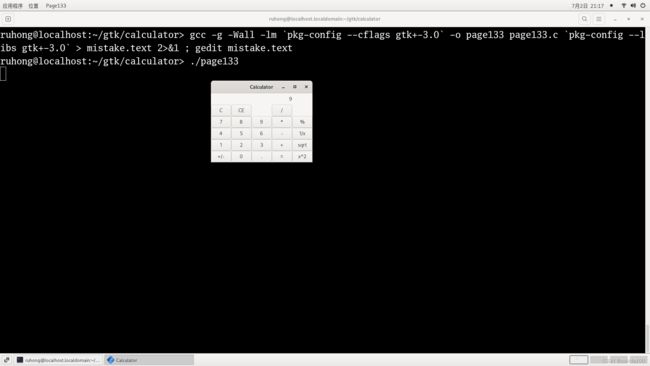第133页的gtk+编程例子——编写计算器应用
第133页的gtk+编程例子——编写计算器应用
以下gtk+编程例子是来自书籍《实用技术:开发Linux应用——用GTK+和GDK开发Linux图形用户界面应用》第133页的内容——编写计算器应用
例子程序是在gtk2.0编译的,已经修改许多地方才能在gtk3.0编译通过,尝试在gtk4.0编译,但是报错太多无法修改而成
书中的例子程序源代码可以到以下地址下载,也有有其它章节的例子程序
《Examples from “Developing Linux Applications with GTK+ and GDK” by Eric Harlow》
https://gitlab.com/steshaw/gtk-examples
《gtk计算器》是在gtk2.0编译的有效果图
https://rtoax.blog.csdn.net/article/details/88089639
在openSUSE-Leap-15.5-DVD-x86_64的gnome41.8桌面环境下编译的,其中pkg-config --cflags gtk±3.0两边有反引号括起来的,pkg-config --libs gtk±3.0也是一样两边有反引号括起来的,因为报错undefined reference to symbol 'sqrt@@GLIBC_2.2.5,所以一定要加上-lm选项,> mistake.text 2>&1 ; gedit mistake.text表示将编译过程的错误信息保存到文本文件mistake.text,编译完成后马上打开查看
ruhong@localhost:~/gtk/calculator> gcc -g -Wall -lm pkg-config --cflags gtk+-3.0 -o page133 page133.c pkg-config --libs gtk+-3.0 > mistake.text 2>&1 ; gedit mistake.text
ruhong@localhost:~/gtk/calculator> ./page133
/*
* Calculator.c
*
* Example showing different widgets in use.
*
*/
#include 参考文章:
《GTK的计算器》
https://blog.csdn.net/zhouzhouzf/article/details/17097999
《编译错误“ undefined reference to ‘sqrt‘ ”解决方法小结》
https://blog.csdn.net/wangqingchuan92/article/details/115261070

